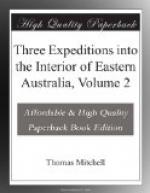JUNCTION OF THE DARLING AND MURRAY.
I struck out of the former line of route for the purpose of extending my measurement to the junction of the rivers, and thus at length found the Darling within a zone of trees which I had formerly taken for the line of the Murray. The banks were high and the channel was also much broader here. After tracing this river about four miles I found that the still but turbid backwater from the larger stream nearly reached the top of the grassy bank of the other. At length I perceived the Murray before me coming from the south-south-east, a course directly opposed to that in which I had followed the Darling for a mile. Both rivers next turned south-west, then westward, leaving a narrow tongue of land between, and from the point where they both turned westward to their junction at the extremity of this ground between them, I found that the distance was exactly three-quarters of a mile. A bank of sand extended further and, on standing upon this and looking back, I recognised the view given in Captain Sturt’s work and the adjacent localities described by him. The state of the rivers was no longer however the same as when this spot was first visited. All the water visible now belonged to the Murray, whose course was rapid, while its turbid flood filled also the channel of the Darling, but was there perfectly still. We were then distant about a hundred miles from the rest of the party who, before we could join them, might have had enough to do with the natives. I thought that in case it might ever be necessary to look for us, this junction was the most likely spot where traces might be sought; and I therefore buried near the point, beside a tree marked with a large M and the word Dig, a phial in which I placed a paper containing a brief statement of the circumstances under which we had arrived there, and our proposed route to the depot, adding also the names of the men with me. As the ground was soft it was not necessary to dig but merely to drop the phial into a hole made with the scabbard of my sabre; and I hoped that the bottle would escape in consequence the notice of the natives.
EFFECT OF ALTERNATE FLOODS THERE.
The greater width and apparently important character of the Darling near its mouth may perhaps be accounted for by supposing that floods do not always occur in it and the Murray at the same time. The remoteness of the sources of the two rivers and the consequent difference of climate may occasion a flood in the one, while the waters of the other may be very low. That this is likely to happen sometimes may be inferred from the difference between the relative state of the atmosphere on the eastern coast and on the Darling. This difference seems to have been so considerable during the last journey as materially to have affected our barometrical measurements taken simultaneously with observations at Sydney. When the bed of the greater river is also the deepest any flood descending




